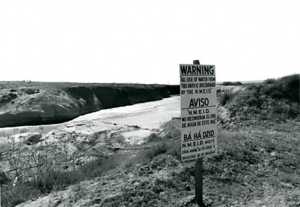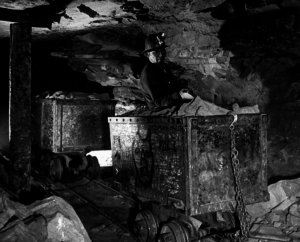 From the late 1940s to the early 1970s, Native American labor extracted approximately four million tons of uranium ore in the Southwest. Employing disparate tribes from the Dakotas to the Pueblo tribes of New Mexico, corporations preyed on Indigenous people from across the United States to harvest their newly found gem of death.
From the late 1940s to the early 1970s, Native American labor extracted approximately four million tons of uranium ore in the Southwest. Employing disparate tribes from the Dakotas to the Pueblo tribes of New Mexico, corporations preyed on Indigenous people from across the United States to harvest their newly found gem of death.
Without fully understanding the toxic environment they were being subjected to, Native workers built mines and dug out uranium from the earth with wheel barrows and pickaxes with no protective gear. Workers drank runoff water from the mine walls and ate within tunnels filled with ionized radiated dust. Workers not only brought the radioactive dust into their homes, but lived near where mining waste was being discarded on the outskirts of towns. The town my own mother lived in as a child was near the Rare Metals waste dump in Arizona where no warning was posted about the hazardous contents of the site.
Tuba City is a large Navajo town that was known for its uranium mill from 1956 to 1966. Later abandoned with radioactive materials left inside, the materials from the mill were then used to rebuild homes and buildings across the reservation. The negative health effects of uranium mining have been well-documented and suspected for centuries starting as far back as 1556, but Native families were kept in the dark about the known hazards of living near and working in the mines.
Uranium mining in the Southwest helped propel the United States into the position of new world leader in the nuclear arms race while continuing the centuries-long genocide of Indigenous people.
Many locations in the Southwest still suffer from the toxic effects of the uranium mining from Utah and northern Arizona to western New Mexico and southern Colorado. Families of sheepherders and pocket communities throughout the reservation are still waiting on funding for cleanup projects promised years ago. Former miners struggle with dangerous health conditions in remote areas of the reservations lacking nearby hospitals and clinics to care for those effected by the deadly legacy of U.S. imperialism. With limited water supplies in the Southwest, generations have grown up drinking from wells contaminated by the uranium mines.
 A recent University of New Mexico study showed high levels of radiation in all the families tested from the local Southwest tribes, including in newborns. The budget for cleanup is estimated to be billions of dollars, but those funds are instead spent on creating more weapons.
A recent University of New Mexico study showed high levels of radiation in all the families tested from the local Southwest tribes, including in newborns. The budget for cleanup is estimated to be billions of dollars, but those funds are instead spent on creating more weapons.
Uranium mining is just one of many ways that Native Americans were used for the profit of corporations and defense budgets. While EPA studies have resulted in some compensation, many of the effected people have already succumbed to lung cancer and other forms of cancer due to radiation exposure. With the passing of these victims, many of the stories of the horrors faced by the uranium miners have been lost. With President Trump continuing efforts to dismantle the EPA and defund research and protections for Native American communities living near these mines, we see a new wave of privatization of government testing facilities. But we must remember that former-president Barack Obama invested 1 trillion dollars into renewing and updating the U.S. nuclear arsenal during his term. The nuclear arms race is being resuscitated by the increasingly aggressive U.S. foreign policy regardless of who sits in the White House.
Some government officials are pushing to reintroduce uranium mining, saying it it will help relieve poverty-stricken communities. While corporations in league with local elites exploit Indigenous communities to reap major profits, we must stand up and fight back for self-determination, to protect our land and defend our people. As the great Indigenous leader Crazy Horse said: “One does not sell the earth upon which the people walk.”





